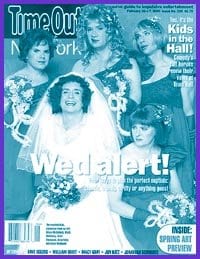I recently stumbled across a website called Staightacting.com where gay men who think effeminacy is a weenie melt can meet the insecurity of their dreams.
Haven’t they been checking out the Prada ads? The way these goombahs go on, you’d think being swish was like having leprosy. The reverse seems more likely.
That’s when I realized that my gay identity has been primarily shaped by non-conformist heterosexual men. I was on the treadmill at the gym, flipping through an ancient, dog-eared copy of a celebrity lifestyle magazine when I spied an intriguing quote by former Kid In The Hall Dave Foley in an article about famous people’s favourite musical pop stars. Like me, Foley came of age in the 1970s. He said that, and I paraphrase, in the ’70s there was David Bowie or there was hell, then there was The Clash.
I agree. Bowie saved my bacon in high school. Mimicking Ziggy Stardust, I dazzled the jocks with glam and, while they were subdued, made my escape.
(Like a couple of the other men I’m about to mention, Bowie has in the past dabbled with boys, but is basically heterosexual. I once furtively dabbled with girls. Just because you don’t turn on the tap doesn’t mean the faucet isn’t working.)
The Clash is great but it wouldn’t have seen the light of day if it hadn’t been for The Sex Pistols, notably Johnny Rotten. From his frock shop on London’s King’s Road, foppish impresario Malcolm McLaren safety-pinned together a patchwork of rough trade boys and a ripped T-shirt trend he ripped off from the burgeoning punk scene across the pond in lower Manhattan. Presto! The Pistols, as one of pop culture’s most successful contrived music groups, right up there with the Monkees and the Spice Girls, turned a fashion statement into a political statement that attracted lots of hot young men and kickass women. How gay is that?
I know Foley and the rest of the Kids In The Hall. Scott Thompson, “the gay one,” is a longtime friend. The others in the group couldn’t have cared less if people thought they were gay or not. Like many straight men in Canadian popular culture, they have a sort of floppy yet articulate gentleness, wedded with an iconoclastic distaste for the status quo that really turns my fag-crank.
For years I thought the clever cultural commentator Geoff Pevere was one of the boys, until I was disappointed to find out otherwise. Canuck film auteurs Don McKellar and Atom Egoyan seem positively fey stacked up against testosterone-driven US counterparts like Oliver Stone and Quentin Tarantino.
Hollywood hires straight Canadian actors to play gay men, gay love objects or femmy straights: Eric McCormack in Will And Grace, Jason Priestley in Love And Death On Long Island, Brendan Fraser in Gods And Monsters, Matthew Perry in Friends, etc.
The Kids In The Hall loved slipping into a frock, a lisp and a send-up at the slightest provocation, having taken over the reins from Monty Python. Of Python’s alumni, only Graeme Chapman was gay, but in the early ’70s their glorious absurdism set the stage for pubescent boys like me, gay or straight, who didn’t quite fit into the normal scheme of things.
Others who have followed in the Brit tradition of dress-draped hets include comedian Eddie Izzard and Australia’s Dame Edna Everage, also known as Barry Humphries. Dressless, but firmly arch of eyebrow, is the fabulously fey but het Brit actor and writer Richard E Grant of Withnail And I fame.
Monty Python originally aired on Canadian TV quite a while before it hit the States because we were readier here for new things. Sophisticated, dandyish, unmarried Pierre Trudeau had just given the country a complete image makeover, decriminalizing homosexuality and booting the state out of our bedrooms. For the first time ever, Canada was sexy.
Maybe that’s why John Lennon decided to have his famous 1970 love-in with Yoko Ono in Canada. Maybe this was a big publicity stunt, but as every well-briefed homosexual knows, companies privatize, fags publicize. Lennon’s statement that global peace stems out of making love could have been part of the gay lib manifesto. Plus, his dry, sardonic wit edged towards the Wildean.
The other evening I was carrying home a box of unfinished pizza from a dinner date with a friend when I came across two teenagers on the sidewalk who were huddled together for warmth. I gave them the pizza and boy were they happy. They didn’t seem to care if I was straight acting or gay acting.
Or overacting for that matter.

 Why you can trust Xtra
Why you can trust Xtra


